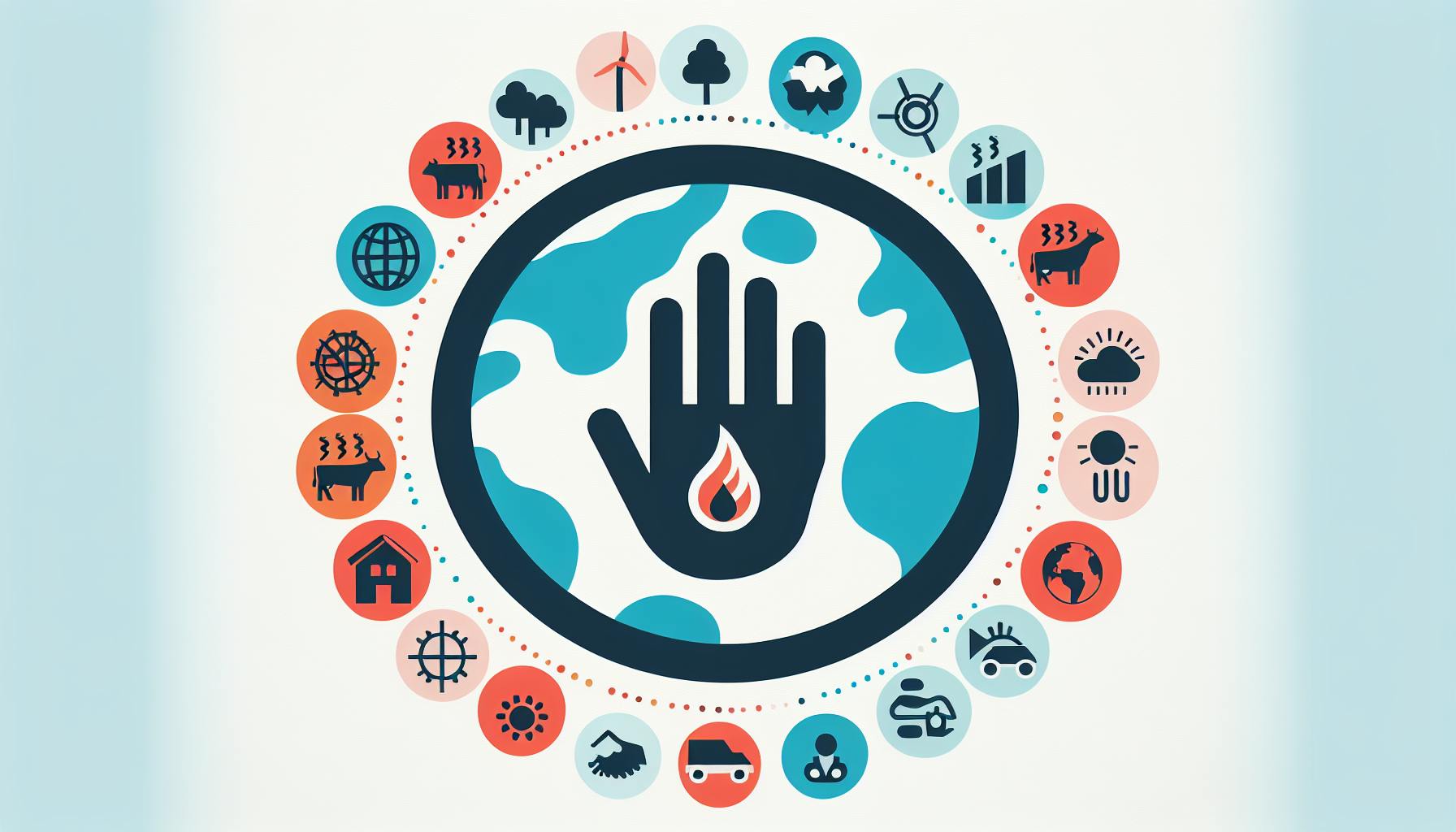GHG offsets offer a practical way for SMEs to counterbalance their carbon emissions, supporting projects that reduce or remove carbon from the atmosphere elsewhere. This guide simplifies the concept and application of GHG offsets for small and medium-sized businesses, highlighting:
- What GHG offsets are: Actions or projects that compensate for emissions elsewhere.
- Why they're beneficial for SMEs: Cost-effective, flexible, and enhance green credentials.
- Challenges and solutions: From limited resources to regulatory complexities, with practical strategies to overcome them.
- Practical strategies: Including streamlining carbon accounting and leveraging offset retailers.
- Real-world examples: Showcasing successful applications by SMEs.
Here's a straightforward look at how GHG offsets can be a key part of SMEs' strategies to become more eco-friendly, addressing both the opportunities and the challenges involved.
Defining GHG Offsets
GHG offsets are basically projects or actions that help reduce, avoid, or capture harmful greenhouse gas emissions to balance out the emissions made by companies elsewhere. Common types of these projects include:
- Renewable energy projects like wind farms or solar panels that replace dirty energy sources
- Forest conservation projects that stop trees from being cut down, keeping the carbon they store safe
- Methane capture projects that prevent harmful gases from escaping from landfills or animal waste
When companies invest in these projects, they can make up for the emissions they can't get rid of themselves. For every tonne of emissions a project reduces, it cancels out a tonne of the company's emissions. This way, businesses can lessen their impact on the climate and work towards being carbon neutral.
The Role of GHG Offsets in Climate Action
Although it's best to reduce emissions directly, offsets are a helpful backup plan for getting to net-zero emissions. When it's too hard, expensive, or time-consuming to cut emissions directly, good-quality offsets can help make up for the emissions that are left over.
Offsets also help pay for projects and technologies that take carbon out of the air, like planting more trees. This helps fight climate change and move towards cleaner ways of living.
If used wisely, offsets can help deal with tough-to-reduce emissions as part of a bigger plan to tackle climate change. Supporting offset projects also shows people you're serious about being green.
Why GHG Offsets Matter for SMEs
Offsets are especially useful for small and medium businesses (SMEs) because:
- Cost-effective: Offsets can reduce emissions at a lower cost than trying to do it all internally. This is great for SMEs that don't have a lot of money.
- Flexible: SMEs can buy offsets to match how much they're emitting each year. This means they don't have to guess their future emissions perfectly.
- Marketing value: By supporting certified offset projects, SMEs can show they're green, which can attract customers who care about the environment.
- Future-proofing: Starting to use offsets now can prepare SMEs for stricter environmental rules in the future.
While it's still important to reduce emissions directly, offsets are a practical way for SMEs to add to their green efforts and aim higher in their climate goals.
The Challenges of Implementing GHG Offsets
Implementing GHG offsets can be a bit tricky for small and medium-sized businesses (SMEs) that don't have a lot of money or people to focus on reducing their carbon footprint. But, with some smart planning, offsets can still be a big help.
Limited Resources and Expertise
- SMEs often don't have much money or many workers, making it hard to spend time and money on climate actions.
- They might not know how to properly figure out their emissions, understand the rules around offsets, or check if a project is really doing what it says.
- It's hard to spend money on offsets when there are other pressing business needs.
Tips to Overcome:
- Look for government help and special deals for eco-friendly projects
- Use easy tools to guess your emissions
- Work with companies that sell offsets and can guide you
- Try a small project first to see how it goes
Navigating Regulatory Complexities
- The rules and standards for offsets can be different depending on where you are. This can be confusing and make it hard to follow the law.
- The rules keep changing, so you need to keep up.
Tips to Overcome:
- Stick to well-known global standards like Gold Standard and VCS
- Check what your local area requires or offers
- Buy from companies that make sure you're following the rules
- Look at the rules once a year and adjust if needed
Financial Considerations and ROI
- It's hard to know how many offsets you'll need as your business changes.
- It's tricky to figure out the money benefits from being more eco-friendly.
Tips to Overcome:
- Start with a small budget based on how much you're currently emitting
- Remember the marketing perks of being seen as green
- Look at different prices before you buy
- Think of offsets as a way to avoid future problems
While it might seem tough, starting slow can help SMEs include offsets without too much stress. The main thing is to find a balance between what you can afford and making a real difference over time.
Practical Strategies and Solutions
Streamlining Carbon Accounting
Making it easier to track your emissions can really help. Instead of collecting data by hand and getting lost in complicated spreadsheets, there are programs like EcoHedge Express that make it easier for small businesses. These programs can connect with your bills, shipping information, and other data to figure out your emissions. They use special calculations for your type of business and help you see where you're emitting the most, making it easier to report and find ways to reduce emissions.
Look for a program that:
- Can automatically gather data related to your emissions
- Uses the right methods to calculate your emissions based on your business type
- Lets you easily report your emissions and see where you can make improvements
- Updates easily as your business grows or changes
Using these types of programs can save you a lot of time and confusion.
Leveraging Offset Retailers and Partnerships
Getting help from experts who know all about carbon offsets can also be a big help. These experts understand the rules and can recommend the best types of offsets for your business. They can make sure the offsets you choose are verified and follow local laws. They might even get you a discount or handle the paperwork for you.
They can help with:
- Picking the right offsets and how many you need
- Making sure your offsets are legit
- Getting discounts
- Taking care of the paperwork
- Helping you tell your customers about your green efforts
Paying a fee for their help can make things a lot easier for you.
Focusing on Co-Benefits
Think of offsets as an investment, not just a cost. There are extra benefits like making your business look good, being ready for future changes, and getting a head start on green initiatives. These benefits can help make up for any extra costs now.
Here's a way to look at it:
| Pros | Cons |
|---|---|
| Know how to manage emissions | Costs per tonne of emissions |
| Get discounts for buying more | Need to commit to a contract |
| Everything is taken care of for you | Less control over specific projects |
| Materials to help with marketing | Risk of being seen as just pretending to be green |
| Saves time and effort | Can't pick and choose projects |
It's important for small businesses to think about what they need and can handle. Working with an offset partner can be a good balance of cost, ease, and flexibility.
sbb-itb-0f1f828
Conclusion and Key Takeaways
GHG offsets are a way for small businesses to balance out the emissions they can't avoid right now. By putting money into projects that reduce emissions, companies can move closer to not adding any carbon to the atmosphere while still working on making their main operations cleaner.
But, it's tough for small businesses to do this all on their own because they might not know how or have enough people to help. Luckily, there are ways to make it easier:
Use simple tools to figure out your emissions
Tools like EcoHedge Express can do the math to find out your emissions for you and point out where you can cut down. This way, you don't have to guess.
Get help from experts
Companies that specialise in carbon offsets can walk you through everything you need to know, like which projects are trustworthy and how to talk about your efforts. Their help can save you a lot of time and effort.
Think about the extra benefits
Using offsets not only helps the planet but can also make your business look good to customers who care about the environment. Just make sure to be honest about what you're doing.
In short, offsets are just one part of what small businesses can do for the environment. With the right tools and help, they can play a big part in the fight against climate change without breaking the bank.
Related Questions
What is GHG offsetting?
GHG offsetting means taking steps to balance out your carbon emissions by supporting projects that reduce or remove carbon from the atmosphere elsewhere. This can include funding wind farms, saving forests, or capturing carbon before it escapes into the air. The idea is to cancel out the emissions you can't avoid by helping to lower emissions somewhere else.
Does Taylor Swift buy carbon offsets?
Yes, Taylor Swift has bought carbon offsets to make up for the pollution from her recent tour. She's trying to balance out the emissions from her private jet and tour activities by investing in projects that reduce carbon emissions. This shows she's making an effort to address climate change, even though cutting down emissions directly is always better.
Is carbon offsetting greenwashing?
Sometimes, yes. Critics like Greenpeace say that some businesses use carbon offsets to look more eco-friendly than they really are, without making big changes to reduce their own emissions. To tell if a company is genuinely eco-friendly, look at whether they are really cutting down their emissions or just relying on offsets.
Why carbon offsets don’t work?
There are times when carbon offsets might not work as intended. This is because it's hard to be sure that the projects really reduce emissions as much as they claim. If the savings aren't real or big enough, then the offsets don't truly balance out the emissions they're supposed to. Making sure offsets really help the climate means picking projects carefully and checking on them to see that they're doing what they promise.



